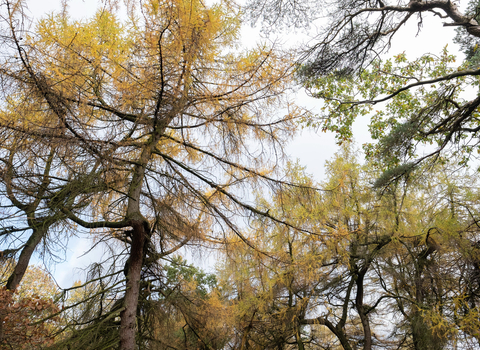The areas of larch plantation are some of the darkest areas of the woodland. By allowing more light in, we will see native broadleaf trees setting seed naturally in these areas. The open areas created by the felling will also aid woodland birds such as pied flycatcher and wood warbler, bringing in more wildlife as well as making the woodland more natural.Staffordshire Wildlife Trust
Diseased larch tree felling at Moorlands beauty spot
Over the course of the winter Staffordshire Wildlife Trust will be felling diseased larch trees at the popular Roaches Nature Reserve near Leek.
The Trust is legally required to complete this work due to larch trees becoming infected by a disease called Phytophthora ramorum in part of the reserve called ‘Back Forest’ near Gradbach. In larch trees, the disease progresses very quickly, killing larch trees which makes them weak and liable to fall.
Visitors are asked to respect signage for closed pathways while the work takes place. The work is set to start this winter, stop during the bird breeding season, and will conclude next winter.
Phytophthora ramorum is an algae-like organism called a water mould. Its spores spread via wind-driven rain. When they land on a leaf they grow into the tree by breaking down the cell walls in the leaf. This leads to the initial blackening symptoms. It then grows within the tree and blocks its water transport system leading to dieback and eventual death. While this process is happening, it will also be spreading spores onto other nearby trees.
Jon Rowe, Land Management Team Manager (North), said:
“Sadly, we must fell a large number of larch trees in Back Forest after Forestry England detected the disease here. Some of the trees are close to footpaths, so we will need to close sections off while the work takes place.”
“To prevent the disease spreading to other areas of larch nearby we are legally required to fell the infected larch trees and those within 200 metres of infected trees. Thankfully, Back Forest has lots of other native trees too, which aren’t at risk, so much of the woodland will not be affected.
The Trust will work with the Forestry Commission to draw up a restoration plan for the area. Jon added:
“As well as monitoring the natural regeneration of broadleaf trees, over the coming years we’ll plant native hardwoods, species such as oak, hazel and birch.
“The areas of larch plantation are some of the darkest areas of the woodland. By allowing more light in, we will see native broadleaf trees setting seed naturally in these areas. The open areas created by the felling will also aid woodland birds such as pied flycatcher and wood warbler, bringing in more wildlife as well as making the woodland more natural.”

